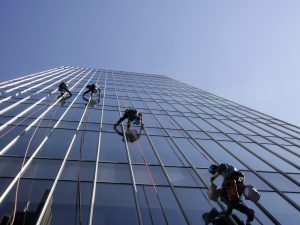You may have heard the term “usurp” before but probably not in the context of scaffolding. Is it possible to usurp in scaffold? And who does the usurping? Is it dangerous? Is it legal? Should you read further? Can you imagine having your scaffold usurped? One of Webster’s (of dictionary fame) definitions for usurp is “to seize or exercise authority or possession wrongfully.” Where, in scaffolding, can one individual usurp, that is, seize something from another? Good examples involve the Federal OSHA Standards.
An excellent example, which occurs more frequently than it ever should, involves the application of the specific standard that addresses fall protection for erectors, namely Regulation 29CFR 1926.451(g)(2). This regulation clearly specifies that a competent person is to determine the feasibility of successfully providing fall protection for scaffold erectors. If fall protection is feasible, then it must be provided. Feasibility includes consideration of a number of factors, including access to a proper anchor, sufficient anchor strength, safe operation, and does not result in increased hazards. To meet these criteria, it should be obvious that proper training is required. In other words, a competent person is required to evaluate the circumstances, can recognize the hazards, and has authority to act. Assuming that the individual in charge of the erection crew is indeed a competent person, why would anybody question this individual’s decision about the feasibility of fall protection? Unfortunately this is exactly what happens on jobsites when a superintendent, for example, requires that scaffold erectors “tie off” in spite of what the scaffold company’s competent person may determine. In other words, the superintendent is usurping the authority of the scaffold company and the scaffold company’s competent person.
As another example, look at the requirement that base plates and proper foundations are required for all supported scaffolds. (29 CFR 1926.451(c)(2)). Because of the poor way the regulation is written, it is unclear as to the requirement for sills. Competent and qualified persons will understand when sills are required and what their size should be. If this is so, why do those involved with safety constantly require sills when they are not necessary, and why do they force erection crews to modify existing sills that are perfectly adequate? Probably because those charged with safety are not competent in the area of scaffold sills. In this example, the safety person has usurped the decision of the competent person, creating needless work and not improving safety in any way.
Another popular area where non-qualified employees like to usurp the authority of competent scaffolders is with access. While the standards are specific in what is expected, commonly an individual who has authority without knowledge usurps the responsibility and authority of the competent scaffold supervisor. Bizarre requirements that do not enhance safety appear from the imagination of the untrained individual. In an effort to satisfy the requirements, and maintain a schedule, the scaffold erector complies. Safety does not improve, authority is usurped, and nothing meaningful is accomplished.
What are the results of such activities where authority is usurped? First and foremost, the effectiveness of the regulations and standards is eroded. Second, confusion reigns on the jobsite. Third, safety is compromised. Fourth, employees are forced to violate standards that affect their personal safety. On the surface, it would appear that the superintendent or other individual is concerned with safety, and more specifically, concerned with the safety of the scaffold erectors. But has safety really been enhanced? What has been gained? Frankly, nothing has been gained and much has been lost. Usurping the authority of the scaffold competent person can easily expose the erectors to additional hazards unknown to the superintendent, may erode the safety of the erection crew, and typically results in violation of OSHA fall protection standards, particularly anchor strength regulations. The bottom line is that the erector fall protection regulation is violated, erector safety is not enhanced, and most probably overall safety is diminished.
What can be done to stop this practice? The obvious solution is that superintendents, safety officers, compliance officers, and others, must respect the decision of the competent person, even if that decision is in disagreement with the opinion of others. Please note that it is important that it is the decisions of competent persons that must be respected. If the individual making the decision demonstrates that he or she doesn’t have the ability to recognize the hazards, then the decision should certainly be questioned. Again, we are referring to the decisions of competentpersons. Next, training must continue for all employees, no matter what position they may hold. Finally, it is important to remember that authority does not necessarily imply knowledge or familiarity with the subject. Competency should be challenged, but only be those with the knowledge to do so. If you cannot recognize the hazard, you aren’t competent. If you aren’t competent, do not usurp the authority of those who are!












